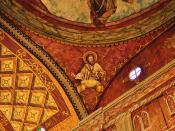The sculpture is ÃÂFiesaÃÂ ÃÂ ÃÂJarabeÃÂ by Luis Jimenez. It is a fiberglass cast, number 4 of 5 total, begun in 1991 and completed in 1996. It is a ten-foot tall polychrome statue with its colors expressed mainly in bright fuchsias, pinks, and blues. It conveys a traditional Mexican hat dance whose participants are a man and a woman.
Several components of the statue help to prove that the artistÃÂs intention was to stir up the conventional and mostly false views of a harmonious Southwestern historic as well as present time period. The components that aid in this goal are the absence of traditional fine art techniques, the statueÃÂs location, and some ÃÂmistakesÃÂ in the work that are actually intentional. It is the combination of these artistic devices that helps the artist use this particular work to aid in the banishment of the idyllic myths of a harmonious Southwest.
Fine art is a term that usually indicates a traditional perspective on the art forms and often implies an association with classic or academic art. In sculpture, especially when referring to the human figure, the forms of fine art tend to be more gracile, or delicate, in nature. The bodies would be portrayed in correct proportion with leanings toward what is generally accepted as classic beauty. Classic beauty implies balance of features and, generally, fair skin. When you think of traditional fine art sculptures you think of something along the lines of the Venus De Milo. This is a statue that complies with our traditional beliefs of what is generally considered to be fine art.
None of Luis JimenezÃÂ works follow these conventional rules. The ÃÂFiesta JarabeÃÂ is no exception. The artist plays with the conventional rules and uses the breaking of them to convey certain points and personal...


